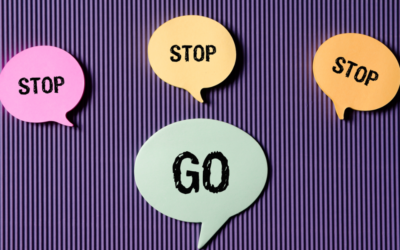First of all I’d like to clarify that your head is a part of your body. It just happens to house your big, beautiful brain that is responsible for all of that thinking ahead, planning, problem solving and reflecting you do so well. These are wonderful features of your thinking mind and can be very helpful when there are tangible problems to solve and that self-reflection arms you with the knowledge of how to do things differently next time.
For anxious folks however, all of that thinking has a dark side: obsessing over something that happened years ago, racing thoughts that won’t quiet down and keep you up at night, predicting all of the worst-case scenarios. In these instances, following the thoughts will only snowball into more anxiety and trying to argue with them or push them away will only give them more ammo to fight back (it’s true: what we resist, persists).
So what is an anxious person to do?
One way to turn the dial down on anxiety is to direct our attention to all the other parts of our body that carry their own kind of intelligence (think emotional, sensing, intuition). When we do this, we invite an opening, a space to get curious and connect with what our physical experience is in the present moment. The anxious thoughts might still be there (that’s OK!), but we’re choosing to shift our focus elsewhere. We move from a place of thinking to a place of sensing, experiencing and embodiment
6 ways to quiet the mind:
1. Notice Your Breath
I really mean just notice it. Don’t try to change anything about it or breathe in a way you think you should be breathing. Your eyes can be open or closed, however most folks notice that it’s easier to drop into their bodies when they close their eyes (if you do this and start to feel more anxious or unsafe open your eyes back up and choose a spot to gaze at a few inches or feet in front of you). You are breathing all of the time – it’s something that happens without you even having to make an effort or do something different (how cool is that?).
So begin to notice it. Feel the air coming in and out of your nose and/or mouth. Get curious about the temperature, sensations, quality (short, long, smooth, choppy, etc). Maybe put a hand over your belly or chest and notice if you feel any movement. There is no right or wrong here. This is an exercise you can do for 10 seconds or 10 minutes. If it feels right and you have a specific breath practice (such as deep belly breathing), feel free to invite that in after a while.
2. Do a Body Scan
Again, your eyes can be open or closed for this exercise. You can begin at the top of your head or the tips of your toes, whatever feels best for you. You’re not trying to change or do anything here, you’re just noticing. For example, if you’re starting with your feet, notice where they are (pressing into the ground? One crossed over the other?) and what sensations you feel (for example cold, warmth, tingling). You don’t even need to worry about naming the sensation, you can just experience it.
Scan up and down your body a few times, taking as long as feels good. It’s normal to notice areas of discomfort or tension that you didn’t realize were there before. That’s good! If you want to, you can visualize sending some relaxation to these areas – perhaps through a visualization of light or imagine sending your breath directly into that area.
3. Tense and Release Your Muscles
This is a more active version of the body scan and is sometimes known as “progressive muscle relaxation” or PMR. Basically, you are going to intentionally bring some tension to individual areas of your body by squeezing, pressing or flexing for a few seconds, then letting that go, bringing relaxation and ease to that same area.
Let’s use your hands as an example. You might curl your hands into fists and notice the sensations this brings to your hands and arms (do your best to keep other areas of your body soft). Hold for 5-10 seconds with an option to take a big breath in as you begin to tense, hold your breath as you’re holding the tension, then take a big exhale out when you release.
If you’re short on time, you can just bring tension to your whole body, squeezing everything in and up, scrunching your face, pulling your shoulders toward your ears, holding, then releasing.

4. Move Your Body
When we’re really anxious or agitated, sometimes coming to a place of stillness can be too much too soon. Your body may be pulsing with adrenaline and the stress hormone cortisol, and in this case, movement is medicine. You don’t have to lace up your sneakers, although going for a walk, run or bike ride can be great.
Even just standing up and stretching your arms up over your head or twisting from side to side in your seat can help release tension. If you have the time, you can pop on a dance, yoga or workout video. Just make sure that it’s something you actually enjoy doing and that feels good in your body.
5. Ground
Make gravity your friend! Like the breath, our connection to the earth is happening all of the time, whether we’re thinking about it or not. When you feel disconnected or caught up in your thoughts, it can be helpful to remind yourself of this earth connection.
This can be as simple as pressing your feet into the ground or noticing all the points of contact your body is making with the seat you’re in. Some folks like to visualize roots extending from their feet or the base of their spine into the earth, or perhaps an image of a big, sturdy tree that stands firm regardless of the weather that surrounds it.
6. Sing (or just make some noise)
When we hum, sing, or even make silly sounds, we engage our breath and also stimulate the longest nerve in our body (the vagus nerve), which helps activate the parasympathetic nervous system (our “rest and digest” system). Tone deaf? Been told you can’t sing? No worries!
As a music therapist, I always let my clients know that this is not about the “product,” but rather the “process” of using your voice for something other than talking. For the more self-conscious amongst us, sighing or humming can be a good place to start. Or put on a favorite song that you love to sing along to.
No matter what method(s) you decide to experiment with, know that coming into a more embodied place takes practice. It’s a good idea to try these methods before you are in an anxiety spiral – that way you’ll have them more “at the ready” when you really need them. Not sure where to begin or which method might be best for you? Working with a therapist who is knowledgeable about mindfulness and somatic practices can help. You can reach out to schedule an initial consultation with me here.




0 Comments